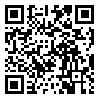Volume 21, Issue 61 (6-2021)
jgs 2021, 21(61): 371-393 |
Back to browse issues page
Download citation:
BibTeX | RIS | EndNote | Medlars | ProCite | Reference Manager | RefWorks
Send citation to:



BibTeX | RIS | EndNote | Medlars | ProCite | Reference Manager | RefWorks
Send citation to:
Hussein T, Mahmoudzadeh A, Ziyari K. (2021). Evaluation of the Performance of Proposed Model of “Service Table” in the Management of Metropolitans from View Point of Urban Good Governance (Case Study of Tehran Metropolitan). jgs. 21(61), : 20 doi:10.52547/jgs.21.61.371
URL: http://jgs.khu.ac.ir/article-1-3892-en.html
URL: http://jgs.khu.ac.ir/article-1-3892-en.html
1- Graduated Ph.D. crisis management, Shakhes Pajouh Research Center, Isfahan, Iran., Shakhes Pajouh Research Center
2- Assistant professor, Shakhes Pajouh Research Center, Shakhes Pajouh Research Center ,info.shakhes@ac.ir
3- Professor of Geography and Urban Planning, University of Tehran, Tehran, Iran., zayyari@ut.ac.ir
2- Assistant professor, Shakhes Pajouh Research Center, Shakhes Pajouh Research Center ,
3- Professor of Geography and Urban Planning, University of Tehran, Tehran, Iran., zayyari@ut.ac.ir
Abstract: (7964 Views)
Tehran metropolitan authorities have always tried to develop the most efficient model for managing Tehran metropolitan affairs. Currently, the Tehran city management model is the council-city model, according to which people elect the members of the city council by direct vote, and the Tehran City Council elects the mayor. Over the past years, and considering that the institutions and organizations in charge of managing and providing urban services have in some cases suffered from parallel work or even inconsistencies in tasks, there is a need to develop a model for integrated urban management. In this article, descriptive-analytical method has been used. This article is practical in terms of the purpose of the study. The purpose of this article is to achieve a model for integrated management of Tehran metropolis. The statistical population of this study is Tehran urban management experts for which 34 people were selected as a sample. The data collection tools of this research are interviews and questionnaires and the data have been analyzed using paired comparison and TOPSIS methods. As a result of this research, according to the identified challenges and using TOPSIS method, the efficiency of the developed research model (with the proposed name of service desk) compared to the current model of Tehran urban management has been confirmed. Also, the most important result obtained from comparative studies is that in the studied metropolises, all matters of governance and urban management are always under the command of one institution and parallel work has been avoided, which should also be considered in Tehran.
Article number: 20
Keywords: Tehran Metropolitan, Urban Good Governance, Urban Management, Systemic Point of View, Service Table.
Type of Study: Research |
Subject:
Geography and Urban Planning
Send email to the article author
| Rights and permissions | |
 |
This work is licensed under a Creative Commons Attribution-NonCommercial 4.0 International License. |

This work is licensed under a Creative Commons — Attribution-NonCommercial 4.0 International (CC BY-NC 4.0)






